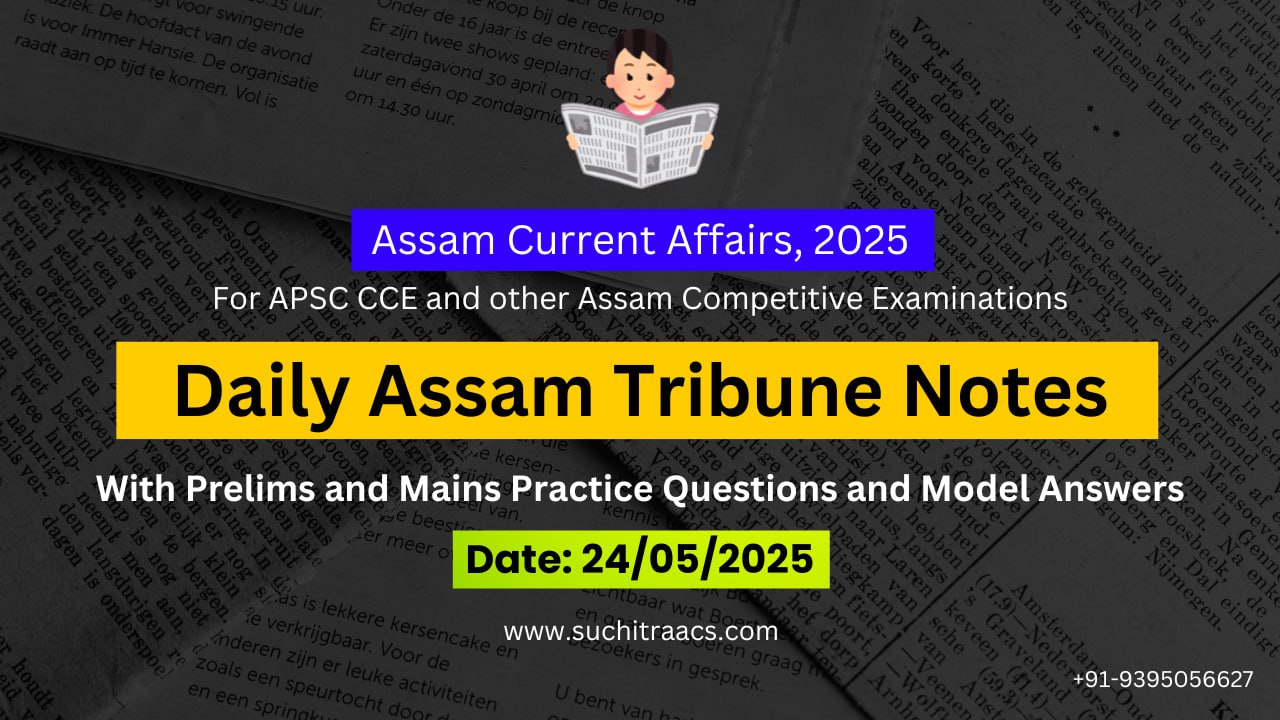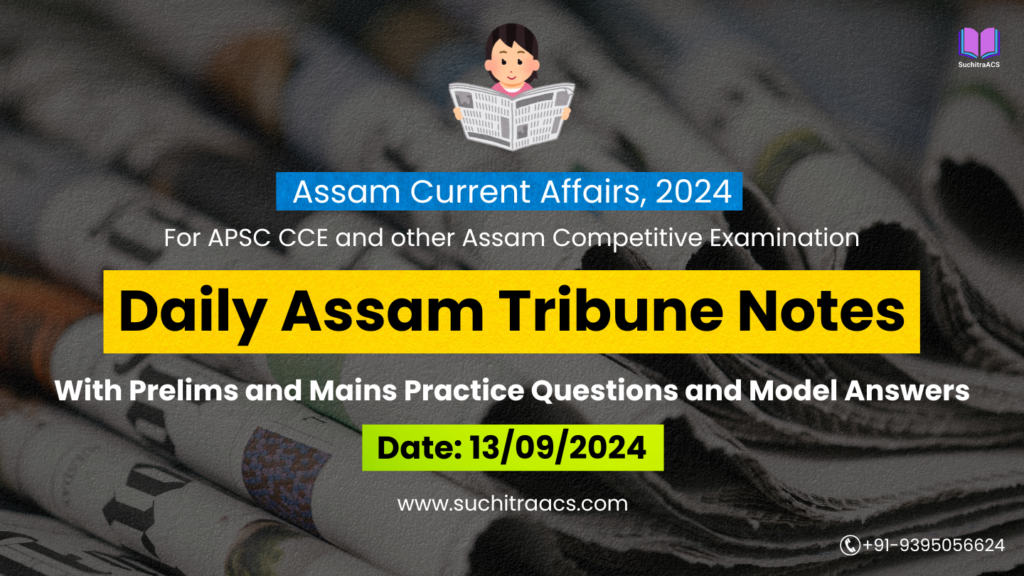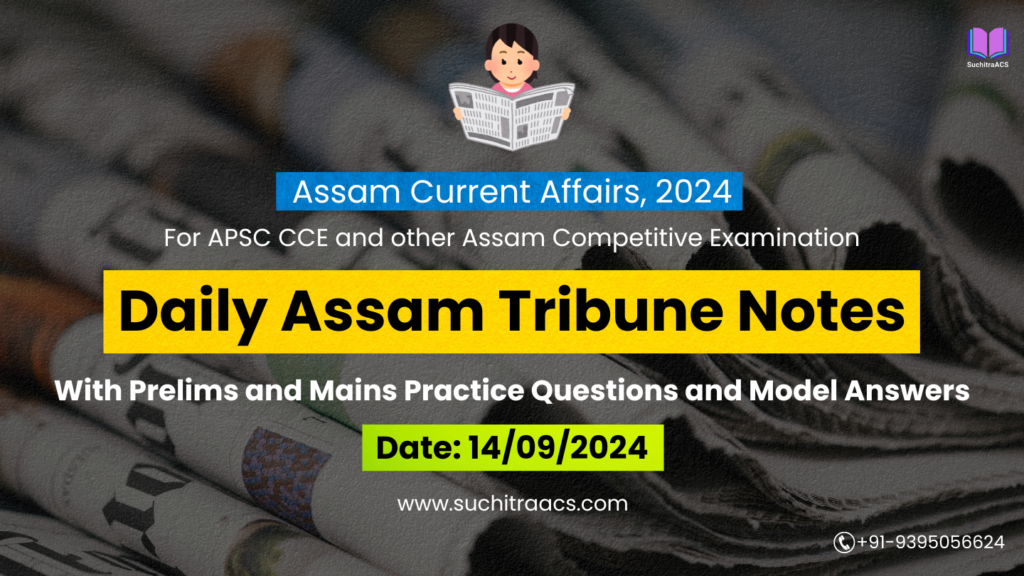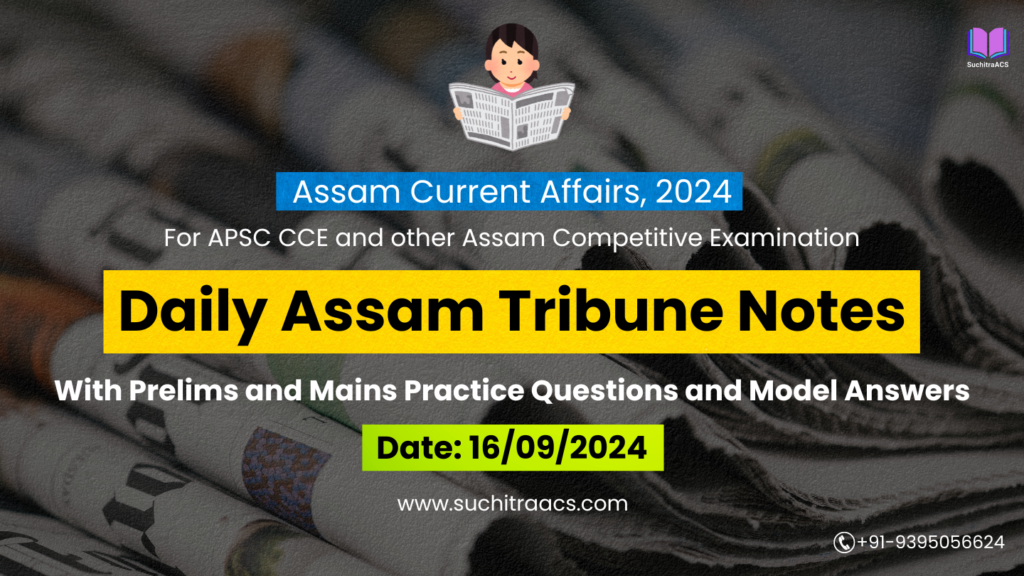APSC Current Affairs: Assam Tribune Notes with MCQs and Answer Writing (24/05/2025)
For APSC CCE and other Assam Competitive examinations aspirants, staying updated with current affairs is vital. This blog covers most important topics from the Assam Tribune today (24-05-2025). These issues are key for both APSC Prelims and Mains preparation, offering insights into the APSC CCE Syllabus.
✨ Current Affairs Crash Course for the APSC Prelims 2025

🟢 Topic: NE as a Complete Package for Tourism – Highlights from the Rising North East Investors Summit 2025
📘 GS Paper 1: Indian Culture | Art Forms | Tourism
📘 GS Paper 2: Government Policies & Interventions
📘 GS Paper 3: Infrastructure | Inclusive Development
📘 APSC GS Paper 5: NE Economy | Assam-specific Growth Initiatives
🔹 Introduction
At the Rising North East Investors Summit 2025 in New Delhi, Prime Minister Narendra Modi described the Northeast as a “complete package for tourism”, highlighting its potential in eco-tourism, adventure sports, organic farming, tea industry, and cultural heritage. The summit emphasized Northeast India’s expanding role in India’s semiconductor ecosystem and global economic landscape.
🔑 Key Highlights
| Feature | Details |
| Event | Rising North East Investors Summit 2025 |
| Venue | Bharat Mandapam, New Delhi |
| Inaugurated by | PM Narendra Modi |
| Key NE Strengths Highlighted | Bio-economy, Bamboo industry, Tea, Petroleum, Eco-tourism, Destination Weddings |
| New Vision | Northeast as a global tourism hub, investment magnet, and part of the semiconductor ecosystem |
⚙️ Prelims Pointers
Rising NE Summit: Annual investment summit focused on entrepreneurship, trade, and sustainability in NE India.
Semiconductor Mission: India’s initiative to build a domestic chip manufacturing ecosystem; NE states now being involved via skilling and logistics hubs.
Destination North East: Flagship event under Ministry of DoNER to promote NE tourism and culture.
Organic Mission NE: Under MoFPI and APEDA for promoting organic farming in Sikkim, Assam, Meghalaya, etc.
Tea Board of India: HQ in Kolkata; Assam is the largest tea-producing state.
📝 Mains Pointers
A. Why NE is Emerging as a Tourism & Investment Hub
Biodiversity & Culture: 8 states, 100+ tribes, 200+ languages – ideal for cultural and eco-tourism.
Geostrategic Gateway: Proximity to ASEAN nations via Act East Policy, trilateral highways, Kaladan Project.
Infrastructure Boom: Road, air, and digital connectivity improving with Bharatmala, UDAN, and telecom expansion.
Sustainability Potential: Organic farming, eco-lodges, and renewable energy hubs being developed.
Youth Skill Ecosystem: Initiatives like PM-DAKSH, IIE Guwahati, and NE Skill Development Council.
B. Challenges to Overcome
| Challenge | Explanation |
| Insurgency Legacy | Affects investor confidence in certain belts |
| Connectivity Gaps | Intra-state transport and digital access in hill districts remain weak |
| Ecological Sensitivity | Need for sustainable tourism norms to avoid environmental degradation |
| Poor Marketing & Branding | NE tourism lacks global-scale outreach campaigns |
| Bureaucratic Delays | Clearance for tourism and industrial projects remains slow in some states |
C. Government Initiatives Supporting NE Development
North East Special Infrastructure Development Scheme (NESIDS) – Supports tourism, health, and connectivity
PM-DevINE Scheme – Fund for critical projects in NE with ₹6,600 crore allocation
Swadesh Darshan 2.0 – Tourist circuit development (e.g., Kaziranga circuit in Assam)
Mission Organic Value Chain Development (MOVCDNER) – Promotes certified organic farming
Startup India and NE Bioresource Missions – Encourage entrepreneurship and biotech research
D. Way Forward
Eco-Tourism Clusters: Develop Kaziranga-Manas-Dibru Saikhowa as a circuit
Public–Private Investment Zones: Especially in hospitality and organic processing
Heritage Tourism Mapping: Digitize monasteries, temples, and oral histories
Skill Development for Guides/Locals: Hospitality and language training for tribal youth
Green Mobility for Tourism: E-buses and river cruises on Brahmaputra
📚 Relevant Reports & Policies
NITI Aayog’s NE Region Vision Document 2035
Assam Tourism Policy 2022
Swadesh Darshan Guidelines (2023)
Invest India North East Desk
State Action Plans on Climate Change (SAPCC)
🧩 Conclusion
The Rising NE Summit underscores that Northeast India is no longer just a cultural frontier but a future-ready economic and tourism destination. With sustained investment, skilled youth, and ecological planning, the region can become India’s sustainable growth engine.
🟢 Topic: Indian Navy Inducts Indigenous Drone ‘Jatayu’ for Coastal Surveillance
📘 GS Paper 3: Internal Security | Indigenisation of Defence | Cyber & Drone Technology
📘 GS Paper 2: Government Policies | Strategic Affairs
📘 APSC GS Paper 5: India’s Maritime Security | Indigenous Tech in NE’s Strategic Context
🔹 Introduction
The Indian Navy has inducted ‘Jatayu’, a long-endurance, indigenously developed tactical drone, into its fleet for coastal surveillance and maritime security. Developed by a private Indian defence startup in collaboration with the DRDO and iDEX, this move is part of India’s growing shift toward Atmanirbhar Bharat in Defence and technology-driven naval preparedness.
🔑 Key Features of ‘Jatayu’ Drone
| Feature | Details |
| Name | Jatayu |
| Type | Tactical Unmanned Aerial Vehicle (UAV) |
| Developer | Private Indian firm with support from DRDO & iDEX |
| Range | ~250 km operational radius |
| Use | Coastal patrol, surveillance, reconnaissance, emergency search |
| Base Deployment | Western and Eastern Naval Commands; includes deployments along Andaman, Lakshadweep, and Eastern seaboard |
⚙️ Prelims Pointers
iDEX (Innovations for Defence Excellence): Launched by Ministry of Defence to support startups in building indigenous defence tech.
Atmanirbhar Bharat in Defence: Focus on self-reliance through Make in India and Defence Acquisition Procedure (DAP 2020).
Indian Navy’s Coastal Security Role: Includes anti-smuggling, search-and-rescue, and marine monitoring.
DRDO: India’s premier R&D body for defence technologies; supports private-sector collaborations under Make-II category.
Jatayu in Indian Mythology: Symbol of valour and sacrifice, a name often used for protective technologies.
📝 Mains Pointers
A. Strategic Significance of ‘Jatayu’ UAV
Enhances Maritime Surveillance: Provides real-time, long-range visibility across India’s 7,500 km coastline
Supports Low-Intensity Maritime Operations (LIMO): Counter-piracy, smuggling, and illegal fishing patrols
Reduces Risk to Human Lives: UAVs can operate in hostile or inaccessible zones during crises
Boosts Indigenous Capabilities: Reduces import dependency; aligns with DAP 2020 focus on Make in India
NE & Eastern Theatre Relevance: Supports maritime awareness in Bay of Bengal and Indo-Pacific
B. Challenges and Considerations
| Challenge | Explanation |
| Signal Jamming and GPS Spoofing | Threat from adversaries targeting UAV comm systems |
| Weather Vulnerability | UAVs face performance issues in cyclonic/coastal turbulence |
| Integration with Naval Command Systems | Requires inter-operability with existing radars, satellites |
| Cybersecurity Concerns | Potential hacking of control systems |
| Maintenance Logistics | Requires trained manpower and continuous component supply |
C. Policy and Development Frameworks
iDEX Prime and SPRINT: Accelerators for defence startup funding and procurement
Defence Testing Infrastructure Scheme (DTIS): Supports UAV testing ranges and simulation labs
Make-II Projects under MoD: No upfront funding; industry builds prototypes with support from DRDO
Maritime Theatre Command (Proposed): A joint command for all naval and coastal operations
India’s Defence Budget (2024–25): ~13% allocated for R&D and tech-driven modernization
D. Way Forward
Expand Indigenous Drone Production: Encourage dual-use UAVs (military + disaster management)
Deploy UAVs for NE Disaster Surveillance: Use in Brahmaputra floods, border monitoring
AI-Integration in Drone Systems: Enable automated threat detection and response
Drone Export Policy for Strategic Allies: Boost India’s defence exports to IOR and ASEAN
Skill Development Hubs: Create drone technician training centers in defence clusters (e.g., Guwahati, Hyderabad)
📚 Relevant Reports & Documents
DAP 2020 – Defence Acquisition Procedure
National Maritime Security Strategy (NMSS)
IDEX Guidelines 2023
DRDO Annual Reports
CAG Performance Review of Indian Navy (2022)
🧩 Conclusion
The induction of ‘Jatayu’ into the Indian Navy reflects India’s growing defence-tech self-reliance and commitment to securing its maritime frontiers through innovation. It represents a critical step in ensuring national security, technological sovereignty, and regional stability, particularly as India asserts itself in the Indo-Pacific strategic landscape.
🟢 Topic: India and Iran Sign 10-Year Chabahar Port Deal
📘 GS Paper 2: International Relations | India’s Neighborhood Policy
📘 GS Paper 3: Infrastructure | Economic Development | Maritime Trade
📘 APSC GS Paper 5: India’s Geostrategic Connectivity | Impact on NE India
🔹 Introduction
India and Iran signed a landmark 10-year bilateral agreement for the operation and development of Chabahar Port, giving India long-term rights to manage and invest in the Shahid Beheshti terminal. The deal marks a major diplomatic milestone, enhancing India’s connectivity to Afghanistan, Central Asia, and beyond, bypassing Pakistan.
🔑 Key Highlights
| Parameter | Details |
| Signed By | India Ports Global Ltd (IPGL) & Iran’s Port Authority |
| Duration | 10 years (with automatic renewal option) |
| Location | Chabahar Port, Sistan-Baluchestan province, Iran |
| Key Feature | India will equip and operate Shahid Beheshti terminal |
| Investment Size | Approx. $370 million committed by India |
| Strategic Objective | Access to Central Asia and Afghanistan via the International North-South Transport Corridor (INSTC) |
⚙️ Prelims Pointers
Chabahar Port: Iran’s only oceanic port on the Gulf of Oman, developed as an alternative to Pakistan’s Gwadar (China’s BRI project).
INSTC: A 7,200 km multimodal trade corridor connecting India with Russia and Central Asia via Iran.
IPGL: A Govt. of India entity under the Ministry of Ports, Shipping and Waterways.
SCO & INSTC Overlap: Central Asian SCO members are part of INSTC’s strategic network.
Chabahar Day: Celebrated annually to promote regional connectivity among IOR and Eurasian countries.
📝 Mains Pointers
A. Strategic Importance of the Agreement
Bypasses Pakistan: Offers India direct access to Afghanistan and Central Asia without using Pakistan’s territory.
Regional Influence: Strengthens India’s foothold in the Gulf and balances China’s presence in Gwadar Port (Pakistan).
Trade Facilitation: Boosts India’s exports of tea, pharmaceuticals, rice, and textiles to landlocked nations.
Connectivity with INSTC: Integrates with rail–road–sea networks connecting Mumbai to Russia via Iran.
Energy Security & Diplomacy: Provides leverage in West Asia and a gateway for future energy trade corridors.
B. Challenges Ahead
| Challenge | Explanation |
| US Sanctions on Iran | May hinder funding, banking channels, and insurance |
| Geopolitical Tensions | Iran-Israel, US-Iran dynamics affect port operations |
| Slow Infra Development | Delays in road/rail linkage from Chabahar to Afghan border |
| Security in Sistan-Baluchestan | Militant threats and drug trafficking risks |
| Coordination with Central Asia | Complex trade and customs negotiations across multiple countries |
C. Impact on India’s Northeast & Act East Policy
Indirect Export Benefits: Assam’s tea, handicrafts, and agro-products can access Central Asian markets via Mumbai–Chabahar route.
Strategic Depth for NE: Complements Kaladan Multimodal and Bangladesh connectivity for an integrated trade strategy.
Alternate to BRI: NE’s role in India’s multilateral diplomacy becomes more central as Chabahar counters China’s influence.
Skilled Labour Export: Opens up port-related training and logistics employment opportunities for NE youth.
D. Way Forward
De-risk Financial Channels: Use rupee-rial trade mechanisms or dedicated banking routes
Accelerate Last-Mile Infrastructure: Invest in road/rail from Chabahar to Zahidan (Iran) and then to Afghanistan
Regional Consensus: Engage SCO, Central Asian republics, and Gulf partners in multilateral trade via Chabahar
Digital Trade Platforms: Integrate Indian exporters with Persian Gulf markets using e-commerce and logistics hubs
Green Port Development: Use solar, automation, and smart surveillance for Chabahar’s sustainability
📚 Relevant Treaties & Frameworks
INSTC Agreement (2002)
SCO Connectivity Charter
India’s Maritime India Vision 2030
PM Gati Shakti Plan – Multimodal connectivity
India–Iran Joint Commission outcomes (2023–25)
🧩 Conclusion
The India–Iran 10-year Chabahar Port agreement is a game-changer for India’s strategic and trade diplomacy, especially in the context of the Indo-Pacific and Eurasia. It reinforces India’s vision of being a net security provider and a connectivity hub, while creating opportunities for economic growth that could ripple into regions like the Northeast through enhanced export and employment pathways.
🟢 Topic: Assam Tea Industry Faces Crisis as Production Costs Rise and Exports Decline
📘 GS Paper 3: Economy | Agriculture & Allied Sectors | Exports
📘 GS Paper 2: Government Schemes | Sectoral Policies
📘 APSC GS Paper 5: Assam-Specific Industry | Tea Economy | Labour Issues
🔹 Introduction
The Assam tea industry, which contributes over 50% of India’s tea production, is facing an economic crisis due to a combination of rising input costs, stagnant auction prices, labour wage issues, and falling exports. The Tea Board and Assam Government have been urged to take urgent remedial action, including a review of the Tea Act and export policy.
🔑 Key Highlights
| Parameter | Detail |
| Production Share (Assam) | Over 50% of India’s tea (approx. 700 million kg annually) |
| Key Issues | Rising input costs (fertilizer, diesel, labour), price stagnation, low exports |
| Export Drop | Export volumes down 10% in FY 2024–25 due to global competition and logistics costs |
| Labour Wage Pressure | Demands for increased minimum wages by unions (currently ~₹250/day in Assam) |
| Industry Representation | Assam Branch Indian Tea Association (ABITA), Tea Board of India |
⚙️ Prelims Pointers
Tea Board of India: Statutory body under the Ministry of Commerce and Industry; oversees regulation and promotion.
Assam Tea: GI-tagged product known for CTC (crush-tear-curl) and orthodox varieties.
Small Tea Growers (STGs): Account for ~50% of Assam’s tea production today.
Price Discovery Mechanism: Through e-auctions under the Tea Marketing Control Order (TMCO), 2003.
India’s Major Tea Export Destinations: Russia, UK, UAE, Iran, and EU.
📝 Mains Pointers
A. Factors Behind the Current Crisis
Rising Input Costs: Fertilizers, pesticides, energy, and packaging materials have seen 20–30% price hikes.
Labour & Social Cost Burden: Tea estates provide housing, healthcare, and education under Plantation Labour Act.
Weak Global Demand: Inflation and shipping disruptions have hit exports, especially to West Asia and CIS nations.
Low Auction Prices: Despite rising cost of production (CoP), prices remain ~₹180/kg.
Climate Stress: Unseasonal rains and pest outbreaks impacting yield and quality.
B. Impacts of the Crisis
| Area | Impact |
| Employment | Over 1 million workers directly affected in Assam |
| STGs Vulnerability | Small growers lack bargaining power and suffer price volatility |
| Global Competitiveness | Countries like Kenya and Sri Lanka are undercutting Indian tea prices |
| Tea Brand Dilution | Adulteration and inconsistent quality threaten Assam’s GI status |
| Export Earnings | Drop in foreign exchange from tea sector |
C. Policy Suggestions & Government Interventions
Reform Tea Act, 1953: To reflect new realities like STG dominance, digital marketing, and auction modernization
Support for STGs: Mini-factories, MSP-like price support, and direct market access
Wage Rationalization Fund: Shared cost model between estates and government
Export Promotion Measures: Freight subsidies, brand promotion campaigns, and FTAs
Tea Tourism & Agro-Processing: Encourage value-addition through boutique packaging and eco-tourism
D. Way Forward
Digitize Auctions: Improve transparency and allow buyer-seller flexibility
Cluster-Based Production Models: Integrate STGs with cooperatives and exporters
Promote Organic & Specialty Teas: Higher margins in niche global markets
Labour Welfare Codes: Integrate plantation welfare with national labour codes
Assam Tea Global Branding Campaign: Use GI status to differentiate Assam Tea internationally
📚 Relevant Reports & Policies
Draft Tea (Promotion and Development) Bill, 2022
APEDA’s Agri Export Policy (2021)
Commerce Ministry’s Export Preparedness Index
Assam Tea Industries Special Incentive Scheme (ATISIS)
India Tea Market Outlook Report, 2024
🧩 Conclusion
Assam’s tea industry is a heritage sector with modern challenges. To remain viable and competitive, it requires a recalibrated policy mix of economic support, global branding, and structural reforms, especially for small growers and plantation workers, who form the backbone of Assam’s rural economy.
APSC Prelims Practice Questions
✅ Topic 1: Rising NE Investors Summit 2025 – Northeast as a Tourism & Investment Hub
Q1. Which of the following is/are key sectors highlighted in the Rising North East Investors Summit 2025?
- Eco-tourism
- Organic agriculture
- Tea and bamboo industries
- Semiconductor ecosystem integration
A. 1 and 2 only
B. 1, 2 and 3 only
C. 2, 3 and 4 only
D. All of the above
✅ Answer: D
Explanation:
The summit emphasized the Northeast’s potential in eco-tourism, organic farming, tea, bamboo-based industries, and even its integration into India’s semiconductor ecosystem through skilling and logistics support.
Q2. Consider the following government initiatives and their relevance to the Northeast:
- PM-DevINE – Infrastructure and development funding for NE
- MOVCDNER – Organic farming value chains in the Northeast
- NESIDS – Special infrastructure projects for NE
- PRAGATI – Skill development program exclusively for NE states
Which of the above are correctly matched?
A. 1, 2 and 3 only
B. 2 and 4 only
C. 1 and 3 only
D. All of the above
✅ Answer: A
Explanation:
Statements 1, 2, and 3 are correctly matched.
Statement 4 is incorrect — PRAGATI is a central monitoring initiative, not a skill development scheme for NE. NE skill initiatives include PM-DAKSH, Skill India NE Cell, etc.
✅ Topic 2: Induction of ‘Jatayu’ Drone in Indian Navy
Q3. The tactical drone ‘Jatayu’ recently inducted by the Indian Navy is primarily used for:
A. High-altitude warfare
B. Deep-sea mining operations
C. Coastal surveillance and maritime monitoring
D. Targeted aerial strikes in enemy territory
✅ Answer: C
Explanation:
The ‘Jatayu’ drone is designed for coastal surveillance, reconnaissance, and maritime security operations, helping monitor India’s vast coastline and island territories.
Q4. Which of the following best describes the iDEX initiative?
A. A start-up accelerator focused on renewable energy
B. A public-private partnership model in agriculture exports
C. A defence innovation program to support indigenous tech by start-ups
D. A digital initiative to improve government e-services
✅ Answer: C
Explanation:
iDEX (Innovations for Defence Excellence) is launched by the Ministry of Defence to support startups and innovators building indigenous defence technologies, including drones, AI, and cyber systems.
✅ Topic 3: India-Iran 10-Year Chabahar Port Agreement
Q5. Chabahar Port is located in which of the following regions?
A. Basra Province, Iraq
B. Gwadar, Pakistan
C. Sistan-Baluchestan Province, Iran
D. Bandar Abbas, Iran
✅ Answer: C
Explanation:
Chabahar Port lies in the Sistan-Baluchestan province of Iran, along the Gulf of Oman, strategically crucial for India’s connectivity with Afghanistan and Central Asia.
Q6. The Chabahar Port agreement is strategically significant because it:
- Provides India direct access to Afghanistan bypassing Pakistan
- Is part of the Belt and Road Initiative (BRI)
- Strengthens India’s role in the International North-South Transport Corridor (INSTC)
A. 1 and 2 only
B. 2 and 3 only
C. 1 and 3 only
D. 1, 2 and 3
✅ Answer: C
Explanation:
Statements 1 and 3 are correct.
Chabahar bypasses Pakistan and integrates with the INSTC.
Statement 2 is incorrect — Chabahar is India-led, while Gwadar (in Pakistan) is part of China’s BRI.
✅ Topic 4: Crisis in Assam Tea Industry
Q7. Consider the following statements regarding the tea industry in Assam:
- Assam contributes over half of India’s tea production.
- Small Tea Growers (STGs) now produce less than 10% of the state’s tea.
- Tea produced in Assam has GI tag status.
Which of the statements is/are correct?
A. 1 and 3 only
B. 2 and 3 only
C. 1 and 2 only
D. All of the above
✅ Answer: A
Explanation:
- Statement 1 is correct — Assam produces over 50% of India’s tea.
- Statement 2 is incorrect — STGs account for nearly 50% of Assam’s tea output today.
- Statement 3 is correct — Assam tea is GI-tagged.
Q8. Which of the following are causes of the current crisis in Assam’s tea industry?
- High input costs and stagnant auction prices
- Decline in global demand and rising competition from Sri Lanka and Kenya
- Increased adoption of drone-based plucking technologies
- Labour wage hikes and plantation welfare burdens
A. 1, 2 and 4 only
B. 1 and 3 only
C. 2 and 4 only
D. All of the above
✅ Answer: A
Explanation:
Drone-based plucking is not yet widely adopted or linked to the crisis.
The crisis is driven by input cost inflation, export competition, and labour cost issues.
APSC Mains Practice Question
📝 Mains Question:
Q. Discuss the challenges faced by the Assam tea industry in recent years. Suggest policy-level interventions that can ensure the sustainability and global competitiveness of Assam’s tea sector.
(GS Paper 3 – Indian Economy | APSC GS Paper 5 – Assam Economy: Agriculture & Industry)
Word Limit: 250
✅ Model Answer:
🔹 Introduction
Assam accounts for over 50% of India’s total tea production, and the industry is central to the state’s economy, employment, and exports. However, in recent years, the sector has been facing a multidimensional crisis marked by rising input costs, labour unrest, stagnant auction prices, and a decline in global exports. These challenges threaten the viability of both large plantations and small tea growers (STGs).
🔍 Key Challenges
- Input Cost Inflation
- Fertilizer, fuel, packaging, and logistics costs have surged, increasing the cost of production.
- Export Decline
- Tea exports fell by ~10% in FY 2024–25 due to competition from Kenya, Sri Lanka, and freight costs.
- Labour Cost Pressures
- Estate owners struggle to meet wage hike demands and maintain welfare services under the Plantation Labour Act.
- Climate Vulnerability
- Unpredictable rainfall, pest attacks, and heatwaves have affected yield and quality.
- Auction Inefficiencies
- Prices remain low (~₹180/kg average), despite rising costs. STGs lack bargaining power.
🛠️ Policy-Level Interventions
| Solution Area | Proposed Action |
| Regulatory Reform | Replace Tea Act, 1953 with a flexible, STG-inclusive legislation |
| Support for STGs | Encourage mini-factories, provide price support, ensure quality assurance |
| Export Promotion | Launch global Assam Tea branding, offer freight subsidies and leverage FTAs |
| Labour Welfare | Implement shared cost model for healthcare, housing and digitize wage disbursement |
| Innovation & Diversification | Promote organic and specialty teas, tea tourism, and packaged value-added products |
🧩 Conclusion
Assam’s tea industry is a heritage economic sector at an inflection point. With responsive policymaking, market reforms, and sustainability-focused interventions, the industry can reclaim its global stature while protecting the livelihoods of over a million workers and small growers across the state.
✨ APSC Prelims Crash Course, 2025

🔔 Join Our WhatsApp Study Group!
For exclusive access to premium quality content, including study materials, current affairs, MCQs, and model answers for APSC CCE and other Assam competitive exams.
Click here to join: SuchitraACS Study WhatsApp Group
📚 Want to know more about SuchitraACS’s most affordable courses?
Click here to know more: SuchitraACS Courses for APSC CCE and Assam Competitive Examinations




